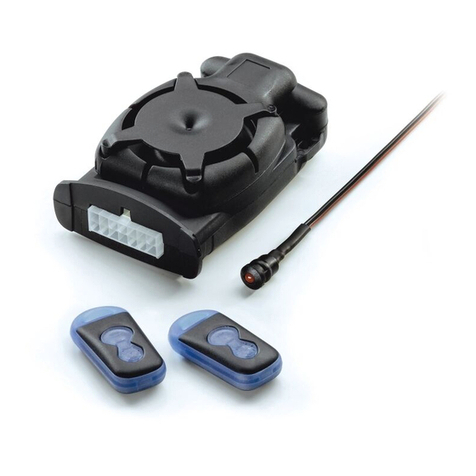DEUTSCH
Stillegen der KTM Alarmanlage
Wird die Alarmanlage länger als einige Stunden von der Fahrzeugbatterie
getrennt, sollte die Anlage nach folgendem Muster stillgelegt werden, um
eine schädliche Tiefentladung des eingebauten Notstromakkus zu vermei-
den:
1. Anlage unscharf schalten.
2. Die gelbe Steckschleife öffnen und Steuereinheit am ATX Stecker trennen.
3. An der Fernbedienung die Taste (2) 3 Sekunden drücken, dabei muss die
Fernbedienung auf der Steuereinheit liegen.
Es erfolgt eine akustische Quittung beim Tastendruck und danach keine
weiteren Signale.
Die KTM Alarmanlage ist jetzt stillgelegt.
Zum Reaktivieren der Alarmanlage verbinden Sie die Steuereinheit wieder
mit dem ATX Stecker und schließen die gelbe Steckschleife.
Nachbestellen einer Ersatzfernbedienung
Im Falle einer verlorenen oder beschädigten Fernbedienung können Sie bei
KTM Ersatzfernbedienungen bestellen. Das Anfertigen einer Ersatzfernbe-
dienung ist nur nach schriftlicher Bestellung unter Beilage einer Kopie des
Kaufnachweises und Angabe der Seriennummer des Alarmsystems möglich.
Notieren Sie daher zu Ihrer Sicherheit die Codenummer ihrer KTM Alarman-
lage! Die richtige Nummer finden Sie auf dem Aufkleber auf der Fernbedie-
nungsrückseite.
Meine Codenummer: S/N A______________________________
5
Problem Ursache Abhilfe
Anlage zeigt keinerlei Reaktion • keine Betriebsspannung an der Alarmanlage • Korrekten Anschluss und Kontakt des roten
und schwarzen Kabels prüfen
• Motorradbatterie ist leer oder hat durch • Batterie aufladen
Kälte zu geringe Spannung
Anlage reagiert nicht auf • Batterie der Fernbedienung leer • Batterie wechseln (Typ A23)
Fernbedienung (LED leuchtet nicht/nur schwach)
• Reichweite der Fernbedienung überschritten • Näher an das Motorrad herangehen
(ca. 30m)
• Sleep-Mode ist eingeschaltet • Sleep-Mode ausschalten
Sehr geringe Reichweite der • Batterie der Fernbedienung leer • Batterie wechseln (Typ A23)
Fernbedienung (LED leuchtet nur schwach)
• Empfangsantenne abgerissen • Anlage zur Reparatur einsenden
• Empfangsantenne in geschlossenem Metall- • Antenne anders verlegen, auf mehr
gehäuse verlegt Abstand zu Metallteilen achten
Sirene klingt merkwürdig oder ist • Die interne Sirene ist beschädigt • Anlage zur Reparatur einsenden
(auch nicht abgedeckt) sehr leise • Wasser in Schallaustrittsöffnung • Anlage so einbauen, dass Wasser aus der
Schallaustrittsöffnung ablaufen kann
Notstromversorgung funktioniert • Gelbe Steckschleife offen • Gelbe Steckschleife schließen
nicht • Akku entladen • Akku aufladen (ca. 8h bei eingeschalteter
Zündung
Zu kurze Alarmdauer, • Akku nicht ausreichend geladen • Akku aufladen(ca. 8h bei eingeschalteter
ungewöhnlicher Sirenenton Zündung
Selbstschärfung trotz eingeschalteter • Blaues Kabel enthält keine 12V bei ein- • Spannung am blauen Kabel bei eingesch-
Zündung geschalteter Zündung alteter Zündung messen , ggf. anderen
Anschlußpunkt wählen.
Auslösung der WfS • Kabelbruch • Kabel unter Zugbelastung auf Durchgang
bei laufendem Motor prüfen, ggf. Kabel auswechseln
• Wackelkontakte • Sicheren Kontakt aller elektrischen
Anschlüsse überprüfen
Gelegentliche Fehlalarme • Sensibilität zu hoch • Niedrigere Empfindlichkeitsstufe wählen
• Motor „knackt“ beim Abkühlen • Anderen Einbauort wählen
• Wackelkontakt in der Kontaktschleife • Verbindung der Kontaktschleife überprüfen
Anlage reagiert zu unempfindlich • Sensibilität zu gering • Höhere Empfindlichkeitsstufe wählen
• Ungünstige Einbauposition • Andere Einbauposition wählen
Fehlerbehebung




























